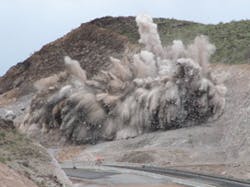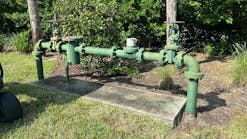Few projects involve the challenges faced by FNF Construction Inc. in building 15 miles of new two-lane roadway through the Black Mountains in Arizona. The two new lanes of US 93, completed in December 2010, run parallel to two existing lanes that lead southward from the new Hoover Dam bypass bridge into Arizona. The $72.7 million project also included milling and resurfacing the asphalt on the existing two lanes, widening two existing bridges, two new mainline highway bridges, 34 box culverts, and numerous pipe culverts.
But it’s the special innovations and challenges that make this project unique:
- FNF built three overpasses for desert bighorn sheep: highway-class bridges crossing all four lanes of US 93, to the tune of $4.8 million. Those bridges are among the first such wildlife crossings in the lower 48 states.
- Approximately 50% of the project’s 3.6 million cubic yards of excavation required drilling and shooting a conglomerate mixture of rock and sand.
- Water for the project had to be pumped 950 feet uphill-over a distance of 4.5 miles-from the Colorado River.
Just recently, FNF and project stakeholders won the 2011 Arizona Transportation Partnering Excellence Award, which is given by a group of major organizations including the Associated General Contractors of America, the American Council of Engineering Companies, the Arizona Department of Transportation, the Federal Highway Administration and the American Public Works Association. What’s more, for its environmental sensitivity the project won FHWA’s Exemplary Ecosystem Initiative, which is given to only 12 projects annually. That’s primarily for the sheep crossings and for placing concrete paths for desert tortoises to use at the outlets of culverts.
Drilling and Shooting
“We had a submersible pump in the river and we used four booster pumps to move water to our main pond onsite,” says Tom Billings, project manager for FNF Construction in Tempe, AZ. “From our main pond we had lines to feed other ponds and overhead tanks. We needed water for our excavation, for dust control, for the aggregate base, and for use in concrete.”
Most of the project consisted of a rock-and-sand conglomerate. “The soil varied,” says Billings. “There was a basalt cut in one section of the job that we had to drill and shoot. And there were some decomposed granite sections with some conglomerate in them. In some areas we could move the dirt with Caterpillar scrapers; if not, we had to drill and shoot.”
Once the conglomerate was drilled and shot, FNF used two Caterpillar 385B excavators to load haul trucks. Five articulated Volvo A35 trucks and three Caterpillar 740 articulated trucks handled the earthmoving chores, assisted by two Cat D10 dozers and one D9. “And we had two Caterpillar 14G motor graders and two Cat 140H blades,” says Billings.
FNF broke the project into three sections. When the box culverts and drainage pipes were complete in one section, mass excavation began. Once the mass excavation was finished, FNF would place the aggregate base for the roadway and begin paving that section.
Wildlife Bridges
The Black Mountains are home to the largest contiguous herd of desert bighorn sheep, and the highway slices through their territory. Before the new bypass bridge opened at Hoover Dam, US 93 was a two-lane road that crossed Hoover Dam and wound its way up the canyon. The sheep had to cross the highway to reach the Colorado River for food and water. Vehicles on the two-lane highway often hit sheep, and the problem would have been even worse with a four-lane thoroughfare.
Initially, the Arizona Department of Transportation (ADOT) tried to coax the sheep across the highway using box culverts, but that didn’t work. The sheep didn’t like them. The sheep like to be up high, so ADOT and FNF obliged them with three concrete overpass bridges. The decks are covered with dirt, so that the sheep will use them. Studies of sheep movements showed where to put the crossings, and, indeed, the animals do use them.
Onsite Crushing
Aggregates came from two sources. “We crushed onsite in two different spots and made aggregate base,” says Billings. “And the mineral aggregates for the hot-mix asphalt came from a pit about five miles from the south end of the project. That’s also where we crushed and washed our concrete aggregates.” A Cedarapids MVP 450 cone crusher handled much of the crushing duties for aggregate base and asphalt.
FNF widened two existing bridges by 14 feet, and built two completely new bridges for the new lanes. For one existing bridge, the contractor completely rebuilt the deck. On the other existing bridge, FNF ground 1 inch off the concrete deck, then replaced that material with 1 inch of special microsilica concrete.
“The reason we broke it into three sections was that there were some crossovers where we would build southbound lanes, and then we would cross over and start building northbound lanes,” says Billings. “Then we’d cross back over and build southbound again. We had to maintain one lane of traffic in each direction at all times. Once we had two new lanes built in a given section, we’d switch traffic onto the new lanes and then mill and resurface the existing two lanes. For the last mile-and-a-half, we rebuilt the entire roadway, because that’s where we tied into the roadway that FHWA was building near the new Colorado River bridge.”
FNF used a Caterpillar PM 565B milling machine to mill asphalt on the existing lanes, and a Caterpillar AP 1055D paver for the paving work. Three, and sometimes four, Caterpillar CB 634D asphalt rollers handled compaction duties. For the existing pavements, FNF milled off 2 inches and laid down a 3-inch mat of asphalt mixed with the Marshall method.
On the new pavements, the contractor placed and compacted a 10-inch aggregate base, then paved with 5 inches of hot-mix asphalt. That was topped with a half-inch of asphalt rubber-wearing course. In Arizona and other Western states, asphalt is typically placed with belly dump trucks that lay down a windrow of hot mix on the road to be paved. That’s what FNF did, and a Cedarapids MS2 windrow pickup machine elevated the asphalt into the Cat paver.
Smoothness Incentives
The quality of paving work succeeded in winning for FNF 90% of the maximum allowable smoothness bonuses available, or $557,000. How did that happen? “First, we buy state-of-the-art equipment, and even more importantly, we have experienced people who are very skilled at what they do,” says Billings. To control grade on the paver, FNF uses an automatic system made by Sauer Danfoss specifically for Caterpillar pavers.
“We keep the paver moving, and we run a consistent mix,” says Billings. “We try to set up roller patterns so that the roller pulls off the mat when it stops. That way we don’t create bumps. And we dial in the asphalt plant to the same rate of production that the paver is running.” If possible, FNF runs contact skis on both sides of the paver, for grade control. The paver worked between 11 and 16 feet wide on the US 93 project.
The Growth in Diverging Diamond Interchanges
An innovation known as a diverging diamond interchange (DDI) promises to reduce traffic congestion, greatly improve safety, and slash construction time and costs for an interstate interchange in suburban Rochester, NY.
Last spring, the New York State Department of Transportation let a $4.93 million construction contract for the interchange, which is located at the intersection of Interstate 590 and Winton Road in Monroe County. The closest alternative interchange, a partial cloverleaf, would have cost an estimated $6.5 million and taken three construction seasons to build, according to Eric Thompson, project engineer for the NYSDOT. By contrast, the new DDI will take just two construction seasons to construct. The project will receive a federal grant from the Highways for LIFE program, which aims to reward innovations that make highways safer, longer lasting, and quicker to build.
With a DDI, the two directions of traffic on the non-freeway road cross to the opposite side on both sides of the bridge at the freeway. Configuration eliminates left turns across traffic and minimizes conflict points, which results in fewer and less severe crashes.
The DDI design reduces the signal operation to two phases, because the protected left-turn phase is eliminated, says Wei Zhang, program manager of intersection/interchange safety with the Office of Safety R&D, Federal Highway Administration. The on-ramp left-turn traffic and the off-ramp left-turn traffic can move simultaneously with the crossing road through traffic, and those would be conflicting movements with conventional diamond interchange design.
The DDI design was first conceived and built in France. Since the successful opening of this nation’s first DDI in Springfield, MO, on June 21, 2009, the pace of DDI implementation has exploded, says Zhang. As of November 2011, at least seven DDIs have been completed in the United States-three in Missouri, one in Tennessee, two in Utah, and one in Kentucky. At least 31 additional DDIs have passed the project selection phase and are in different stages of design and construction.
Experience from the Missouri Department of Transportation indicates that a DDI costs 60% less than a Single Point Urban Interchange (SPUI) that can carry similar traffic flow, and takes one-third of the time to construct, says Zhang. One year’s crash experience from the nation’s first DDI showed reductions of 24% and 100% in rear-end and left-turn-angle crashes, respectively. Those are two of the predominant crash types in the “before” condition. FHWA is evaluating the operational and safety performances of six DDIs, Zhang says.
Thompson said he understood there was a reduction in total crashes of 60% since MoDOT opened the DDI at Springfield. “So if we get anything even close to that we would be extremely pleased,” Thompson says.
Smoothness on the Fly
A Pennsylvania contractor received a substantial smoothness bonus involved in paving an 8-mile stretch of southbound Interstate 79 at a location 30 miles north of Pittsburgh, PA.
IA Construction Corp., of Zelienople, PA, placed 53,600 tons of asphalt for the project under a contract with the Pennsylvania Department of Transportation (PennDOT). The project opened to traffic on August 30, 2011.
The existing pavement consisted of a 10-foot outside shoulder, two 12-foot lanes and a 4-foot inside shoulder. PennDOT broke the job into two 4-mile sections and IA built them in similar fashion. In the first phase of work IA used a Wirtgen 1200 milling machine to mill 12 inches deep on a 4-foot-wide section of the outside shoulder. Next, Plum Contracting, a subcontractor, installed a 6-inch underdrain system in that trench to assure proper drainage. IA then placed 4 inches of subbase asphalt into the trench, followed by 8.5 inches of 25-mm Superpave hot mix asphalt.
Then the contractor switched traffic onto the travel lane and outside shoulder while work began on the fast lane and shoulder. Donegal Construction used a Roadtec 900 milling machine to mill off the 4-foot inside shoulder and the 12-foot fast lane. Concrete lay beneath asphalt in the fast lane, and the asphalt varied in depth from 4 to 5 inches.
Before paving, the 4-foot shoulder was excavated with the Wirtgen 1200 milling machine. Plum Contracting then installed a 6-inch underdrain system in the trench and IA followed up with 4 inches of subbase asphalt and 25 mm of hot mix. Then Kelcris Corp. repaired the concrete on the fast lane.
Paving with a Caterpillar AP 1055 asphalt paver came next. “We ran cross-slope on our binder course and covered the 12-foot lane and the 4-foot shoulder,” says Keith Scott, general superintendant for IA Construction. “And we put a safety notch wedge joint down the centerline. Then we put a 9.5-mm leveling course on top of the binder course, put traffic back on the fast lane and proceeded to mill out the existing travel lane to start the process all over again.
“We milled out the 12-foot travel lane to concrete and then milled the 4-foot outside shoulder,” says Scott. “So 4 to 5 inches of the asphalt that we placed for the underdrain came back out again.” With traffic in the fast lane, IA milled the 12-foot travel lane to concrete, and milled out 4 feet of the shoulder where the 25-mm mix had been placed earlier. Then the contractor paved the travel lane working at 16-feet wide with the Cat paver.
Topcon grade controls and a Roadtec Shuttle Buggy helped with smoothness. The Shuttle Buggy receives asphalt from the trucks, remixes it and acts as a holding hopper before conveying the material to the paver. That way, the Shuttle Buggy ensures that the paver always has asphalt, and the paver never has to stop.
PennDOT had specified that the leveling course should go down first, then the binder course, but IA Construction secured permission to reverse the order. “I thought we’d get a better ride out of it to place the binder course first, because the concrete was in pretty rough shape,” said Scott. “Some of the joints were fairly wide, so we placed the variable-depth course first. That way we had a uniform thickness of the leveling course over the top of a variable-depth course.”






